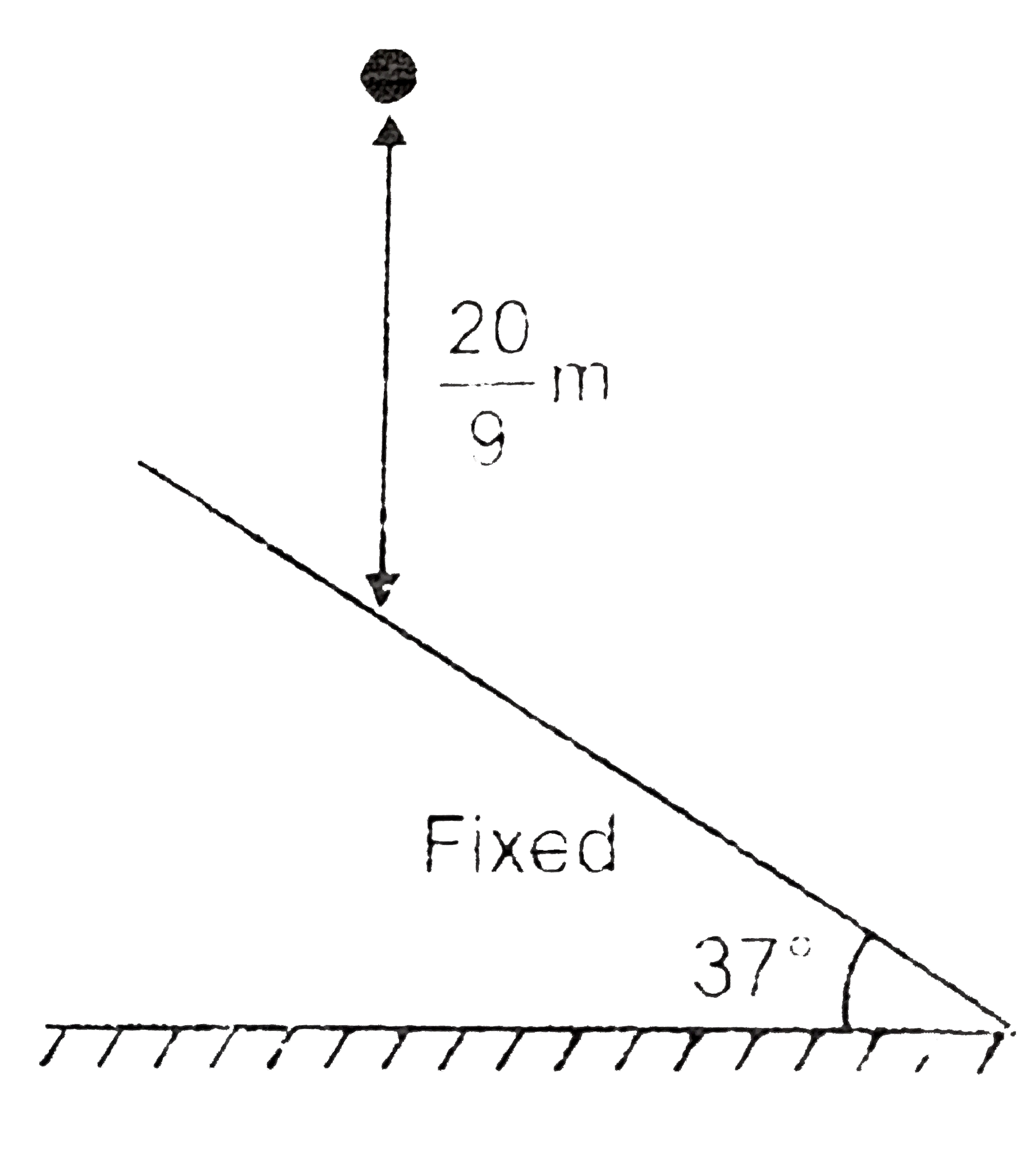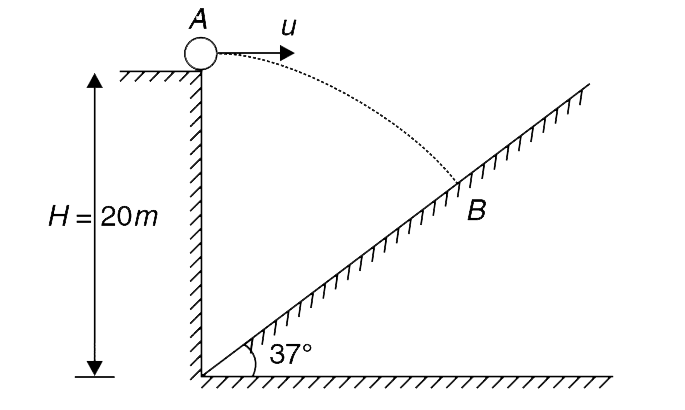A ball is dropped on a smooth inclined plane and is observed to move horizontally after the impact. The coefficient of restitution between the plane and ball is e. The inclination of the plane is
45∘
tan−1e
tan−1√e
tan−1(e2)
The correct Answer is:C
To solve the problem, we need to analyze the motion of the ball as it collides with the inclined plane and determine the angle of inclination (θ) based on the coefficient of restitution (e).
1. Understanding the Problem:
- A ball is dropped onto a smooth inclined plane and bounces off, moving horizontally after the impact.
- The coefficient of restitution (e) is defined as the ratio of the velocity of separation to the velocity of approach.
2. Identify the Velocities:
- Let the velocity of the ball just before the impact be V.
- The velocity of the ball can be resolved into two components relative to the inclined plane:
- Along the incline: Vcos(90∘−θ)=Vsin(θ)
- Perpendicular to the incline: Vsin(90∘−θ)=Vcos(θ)
3. Velocity After Collision:
- Let U be the velocity of the ball after the collision.
- The component of the velocity of separation (after collision) perpendicular to the incline is Ucos(θ).
4. Applying the Coefficient of Restitution:
- The coefficient of restitution is given by:
e=Velocity of SeparationVelocity of Approach=Ucos(θ)Vsin(θ)
5. Rearranging the Equation:
- Rearranging gives:
Ucos(θ)=eVsin(θ)
6. Considering the Horizontal Motion:
- After the impact, the ball moves horizontally, which means the vertical component of the velocity after the impact is zero.
- Thus, the vertical component of the velocity before the impact must equal the vertical component after the impact:
Vcos(θ)=Usin(θ)
7. Setting Up the Equations:
- From the two equations derived:
1. Ucos(θ)=eVsin(θ)
2. Vcos(θ)=Usin(θ)
8. Substituting for U:
- From the second equation, we can express U:
U=Vcos(θ)sin(θ)
9. Substituting into the First Equation:
- Substitute U into the first equation:
Vcos(θ)sin(θ)cos(θ)=eVsin(θ)
- Simplifying gives:
Vcos2(θ)sin(θ)=eVsin(θ)
- Canceling V (assuming V≠0):
cos2(θ)sin(θ)=esin(θ)
10. Rearranging:
- Rearranging gives:
cos2(θ)=esin2(θ)
11. Using Trigonometric Identity:
- Using the identity sin2(θ)+cos2(θ)=1:
1−esin2(θ)=esin2(θ)
1=(1+e)sin2(θ)
sin2(θ)=11+e
12. Finding θ:
- Therefore, we can find θ:
θ=sin−1(√11+e)
- Alternatively, we can express this in terms of tangent:
tan(θ)=√e
θ=tan−1(√e)
Final Answer:
The angle of inclination θ is given by:
θ=tan−1(√e)
- A ball is dropped onto a smooth inclined plane and bounces off, moving horizontally after the impact.
- The coefficient of restitution (e) is defined as the ratio of the velocity of separation to the velocity of approach.
- Let the velocity of the ball just before the impact be V.
- The velocity of the ball can be resolved into two components relative to the inclined plane:
- Along the incline: Vcos(90∘−θ)=Vsin(θ)
- Perpendicular to the incline: Vsin(90∘−θ)=Vcos(θ)
- Let U be the velocity of the ball after the collision.
- The component of the velocity of separation (after collision) perpendicular to the incline is Ucos(θ).
- The coefficient of restitution is given by:
e=Velocity of SeparationVelocity of Approach=Ucos(θ)Vsin(θ)
- Rearranging gives:
Ucos(θ)=eVsin(θ)
- After the impact, the ball moves horizontally, which means the vertical component of the velocity after the impact is zero.
- Thus, the vertical component of the velocity before the impact must equal the vertical component after the impact:
Vcos(θ)=Usin(θ)
- From the two equations derived:
1. Ucos(θ)=eVsin(θ)
2. Vcos(θ)=Usin(θ)
- From the second equation, we can express U:
U=Vcos(θ)sin(θ)
- Substitute U into the first equation:
Vcos(θ)sin(θ)cos(θ)=eVsin(θ)
- Simplifying gives:
Vcos2(θ)sin(θ)=eVsin(θ)
- Canceling V (assuming V≠0):
cos2(θ)sin(θ)=esin(θ)
- Rearranging gives:
cos2(θ)=esin2(θ)
- Using the identity sin2(θ)+cos2(θ)=1:
1−esin2(θ)=esin2(θ)
1=(1+e)sin2(θ)
sin2(θ)=11+e
- Therefore, we can find θ:
θ=sin−1(√11+e)
- Alternatively, we can express this in terms of tangent:
tan(θ)=√e
θ=tan−1(√e)
The angle of inclination θ is given by:
θ=tan−1(√e)
Topper's Solved these Questions
Similar Questions
Knowledge Check
A ball is dropped on a horizontal surface from height h. If it rebounds upto h2 after first collision then coefficient of restitution between ball and surface is
A1√2B12C14D12+√2A ball is dropped on a large smooth inclined plane of angle of inclination 37∘, from a height of 209m above the point of impact. The coefficient of restitution of the impact is e=916 then :
[Take g=10m/s2]
 AThe velocity of the ball just after the first impact is 5 m/sBThe maximum distance between the incline and the ball between the first and second impact is 916mCThe time interval between the first and second impact between the ball and incline plane is 34sDThe time interval between the first and second impact between the ball incline plane is 2s.
AThe velocity of the ball just after the first impact is 5 m/sBThe maximum distance between the incline and the ball between the first and second impact is 916mCThe time interval between the first and second impact between the ball and incline plane is 34sDThe time interval between the first and second impact between the ball incline plane is 2s.A body takes just twice the time as long to slide down a plane inclined at 30∘ to the horizontal as if the plane were frictionless. The coefficient of friction between the body and the plane is
A√34B√3C43D34
A ball is projected from point A in horizontal direction with a velocity of u=28m/s. It hits the incline plane at point B and rebounds. Show that whatever be the coefficient of restitution between the ball and the incline, the ball will always hit the incline for the second time at a point above B (i.e., it will not hit the incline below B). Assume the incline to be smooth and take g=10m/s2[sin37∘=35]

View SolutionA block of mass m is at rest on a rough inclined plane of angle of inclination θ. If coefficient of friction between the block and the inclined plane is μ, then the minimum value of force along the plane required to move the block on the plane is
View SolutionA block of weight 1 N rests on a inclined plane of inclination θ with the horizontal. The coefficient of friction between the block and the inclined plane is μ. The minimum force that has to be applied parallel to the inclined plane to make the body just move up the plane is
View SolutionA ball collides with an inclined plane of inclination θ after falling through a distance h. if it moves horizontal just after the impact, the coefficient of restitution is
View SolutionA block sliding down on a rough 45∘ inclined plane has half the velocity it would have been, the inclined plane is smooth. The coefficient of sliding friction between the block and the inclined plane is
View Solution
